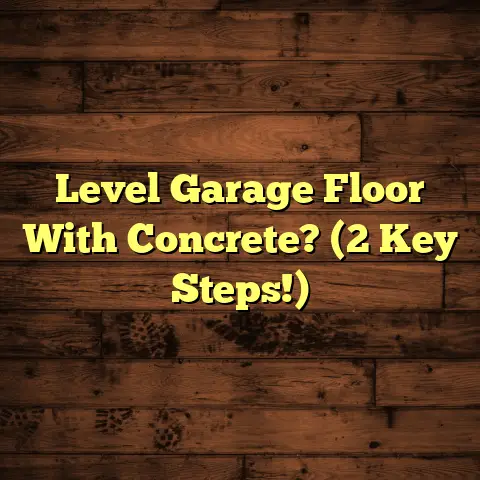How Much Does It Cost To Have Laminate Flooring Installed? (Explained)
When thinking about new flooring for your home, it’s all about functionality. I’ve seen firsthand how the right flooring can transform a space, making it feel more inviting while also serving practical purposes. Laminate flooring, in particular, has become a popular choice for many homeowners due to its affordability and versatility. Over the years, I’ve installed it in various settings—from cozy living rooms to bustling kitchens—and I’ve come to understand the intricacies involved in both the installation process and the costs associated with it.
What to Expect with Laminate Flooring Costs
Let’s talk numbers. The cost to install laminate flooring can vary significantly based on several factors, including material quality, labor costs, and your location. Generally, you can expect to pay between $1.50 and $5.00 per square foot for materials alone.
When I first started in this industry, I remember working on a residential project where the homeowner decided to go with a mid-range laminate. The material cost came to around $2.50 per square foot, which seemed reasonable at the time. Once we added in the installation costs—typically ranging from $2.00 to $4.00 per square foot—the total cost began to add up quickly.
In my experience, a typical installation for a 1,000-square-foot area could run anywhere from $3,500 to $7,000 when you factor in materials and labor.
Breakdown of Costs
Materials
- Low-End ($1.50 – $2.00/sq ft): Basic laminate with minimal texture.
- Mid-Range ($2.00 – $3.50/sq ft): More durable options with better aesthetics.
- High-End ($3.50 – $5.00/sq ft): High-quality laminate that mimics hardwood or stone.
Labor
Installation typically adds another $1.50 – $4.00 per square foot depending on the complexity of the job and your region’s labor rates. In my experience, urban areas tend to have higher labor costs than rural ones.
Hidden Costs to Consider
While you might be focused on the visible costs of laminate flooring, don’t overlook potential hidden expenses:
- Underlayment: You will likely need an underlayment, which can cost around $0.50 to $1.00 per square foot.
- Removal of Old Flooring: If you need to remove old flooring, which can cost an additional $1.00 to $3.00 per square foot.
- Baseboards and Trim: New trim can add another $1.00 to $2.00 per linear foot.
My Experience with FloorTally
When I began using FloorTally, I noticed a significant shift in how I approached cost estimation for flooring projects. The platform pulls local material and labor rates, allowing me to provide clients with realistic budgets right from the start. For instance, during a recent project, I was able to input the measurements of a living room and use FloorTally to generate an accurate estimate that included material costs, underlayment, and labor—all in one go.
Installation Process
Once you’ve settled on materials and nailed down your budget (thanks to tools like FloorTally), it’s time for installation. Here’s how I typically approach it:
- Preparation: Ensure the subfloor is clean and dry.
- Acclimation: Let the laminate acclimate in the room for at least 48 hours.
- Underlayment: Install underlayment if required.
- Plank Installation: Start laying planks from one corner of the room, ensuring proper alignment and spacing.
I remember one challenging installation where the room had numerous angles and corners. It required a lot of careful measurement and cutting, which was time-consuming but ultimately rewarding when we saw how great it turned out.
Maintenance Tips
Keeping your laminate flooring looking great doesn’t have to be complicated:
- Regular Cleaning: Use a microfiber mop or a vacuum designed for hard floors.
- Avoid Excess Water: Too much water can warp laminate; just use a damp mop.
- Use Rugs in High Traffic Areas: This helps prevent wear and tear.
Comparing Options
While laminate flooring is fantastic, it’s important to consider other flooring options that may suit your needs:
- Hardwood: Offers timeless appeal but comes at a higher cost and requires more maintenance.
- Vinyl Plank: More waterproof than laminate and often cheaper but may not have the same aesthetic appeal.
I once had a client who was torn between laminate and vinyl plank for their kitchen remodel. After discussing their lifestyle—kids and pets—it became clear that laminate was the better option for them because of its durability and ease of cleaning.
Benefits of Laminate Flooring
One of the standout features of laminate flooring is its incredible versatility. It comes in various designs that can mimic hardwood, tile, or even stone at a fraction of the cost. This means you can achieve a high-end look without breaking the bank.
Another advantage is its ease of installation. Many laminate products feature a click-lock design that allows for quick assembly without glue or nails. I remember a project where we finished installing over 1,200 square feet of laminate in just two days because of this feature.
Challenges with Laminate Flooring
Despite all its advantages, laminate flooring does have its challenges. One common issue I’ve encountered is moisture sensitivity. While newer laminate options are designed to be more water-resistant, they still don’t perform well in areas prone to high humidity or standing water—like bathrooms or basements.
I once had a client who chose laminate for their basement renovation without considering moisture levels. Unfortunately, after a heavy rainstorm, they discovered some buckling along the edges of their flooring because water seeped through cracks in the foundation. It was a tough lesson learned, but we were able to replace the damaged planks with minimal fuss.
Factors Influencing Installation Costs
When estimating installation costs for laminate flooring, several factors come into play:
- Room Size: Larger rooms lead to lower per-square-foot costs due to economies of scale.
- Complexity of Layout: More angles or obstacles will increase installation time and cost.
- Labor Rates in Your Area: As mentioned before, urban areas typically have higher rates.
- Material Quality: Higher quality materials often come with higher costs but may save you money in repairs and replacements down the line.
The Importance of Proper Preparation
Before any installation begins, preparation is key to ensuring a smooth process and optimal results. This includes:
- Subfloor Condition: Any imperfections in your subfloor can lead to issues down the line.
- Acclimating Materials: Allowing your laminate planks to acclimate helps prevent expansion or contraction after installation.
I once had an installation where the subfloor was uneven due to settling in an older home. We had to spend additional time leveling it out before we could proceed with laying down the laminate, which added unexpected costs.
Tools Needed for Installation
If you’re considering a DIY approach, here are some essential tools you’ll need:
- Measuring Tape: Accurate measurements are critical.
- Circular Saw or Miter Saw: For cutting planks to fit.
- Pull Bar and Tapping Block: Essential for locking planks together without damaging them.
- Knee Pads: Your knees will thank you after long hours on hard surfaces!
Eco-Friendly Options
In recent years, I’ve noticed an increase in eco-conscious consumers looking for sustainable flooring solutions. Some manufacturers produce laminate flooring using recycled materials and low-VOC adhesives, making them more environmentally friendly.
For instance, I worked on a project where clients specifically requested eco-friendly materials for their home renovation. We found a beautiful laminate that met their criteria without sacrificing aesthetics or durability.
A Personal Anecdote
I once helped a young couple install laminate flooring in their new home—a decision they made after months of searching for something that fit their budget while still achieving the look they wanted. They were thrilled when they discovered how realistic some of the high-end laminates looked compared to hardwood.
During installation, we played music and shared stories about our favorite home improvement projects while laying down each plank together. It turned into more than just an installation; it became an experience where they learned about caring for their flooring while enjoying quality time together.
Future Trends in Laminate Flooring
As technology continues to evolve, so does the world of flooring options available today. With advancements in manufacturing processes, we are seeing more realistic textures and patterns that make laminate even more appealing.
Additionally, smart technology integration is becoming increasingly common within home design—think self-cleaning or temperature-regulating materials! While these innovations might not yet be standard in laminate flooring, it’s exciting to think about what the future holds.
Conclusion
Installing laminate flooring can be an excellent investment for any homeowner looking for budget-friendly options without sacrificing style or functionality. By understanding the costs involved, utilizing tools like FloorTally for accurate estimates, and following best practices for installation and maintenance, you’ll set yourself up for success.
If you’re considering this route, take your time choosing materials that suit your taste and lifestyle while being mindful of your budget constraints. With careful planning and execution, you’ll love the results—just as I have in my numerous projects over the years!
If you’ve faced any challenges or successes with laminate flooring installations in your own home or business, I’d love to hear about them! Sharing experiences can often lead us all to better decisions and smarter choices when it comes to our flooring needs!





